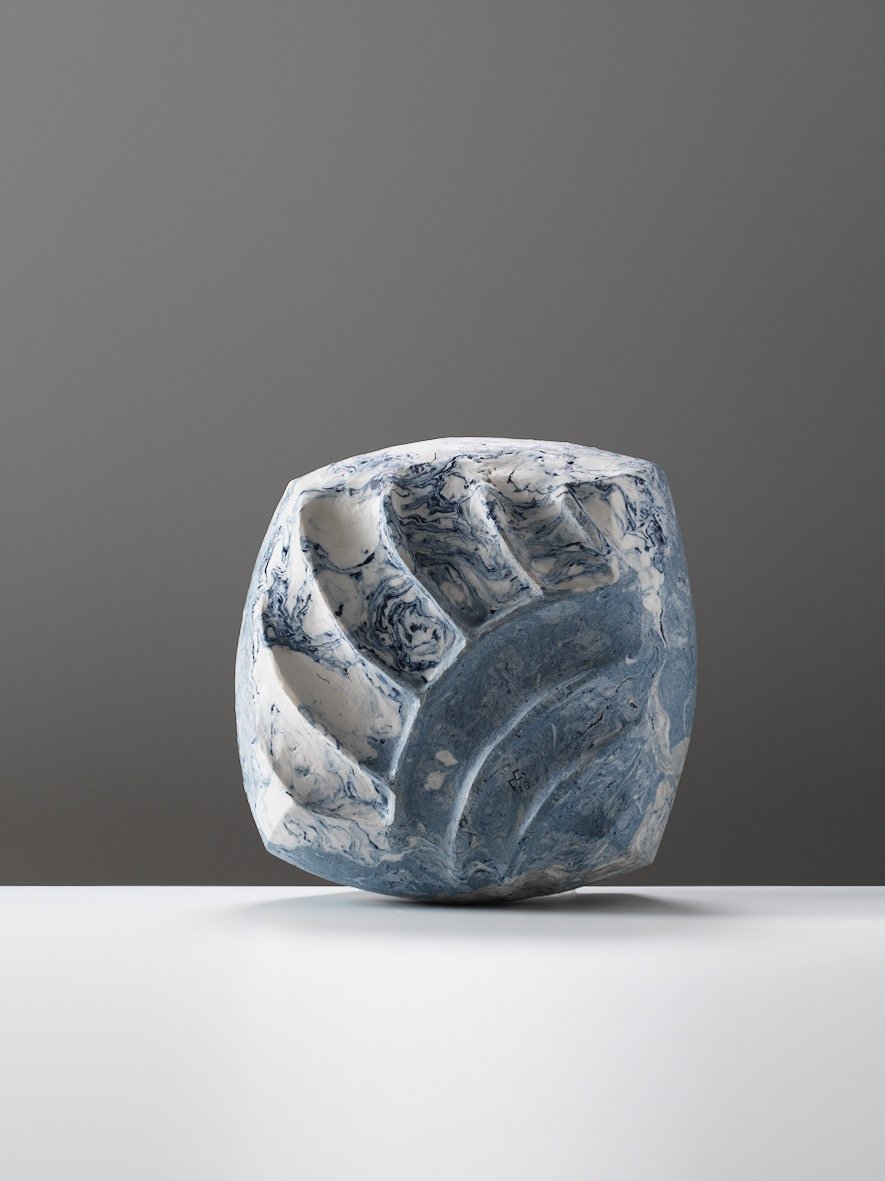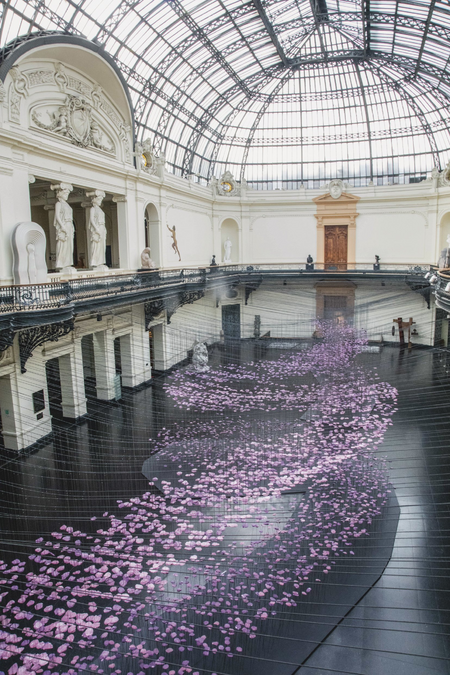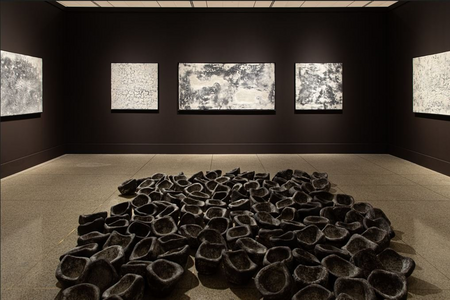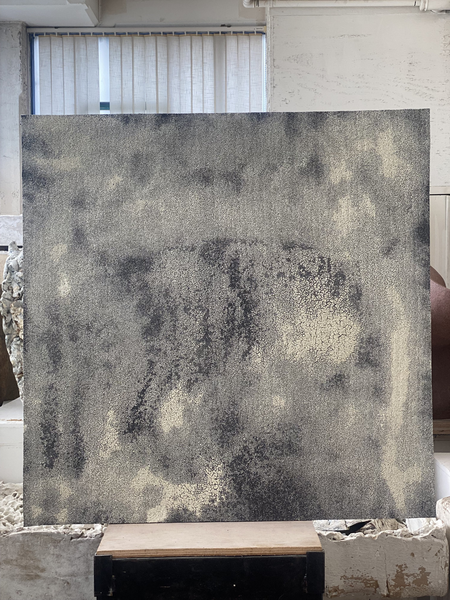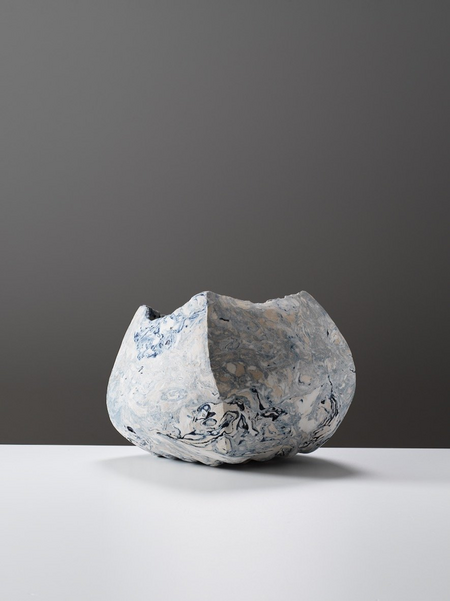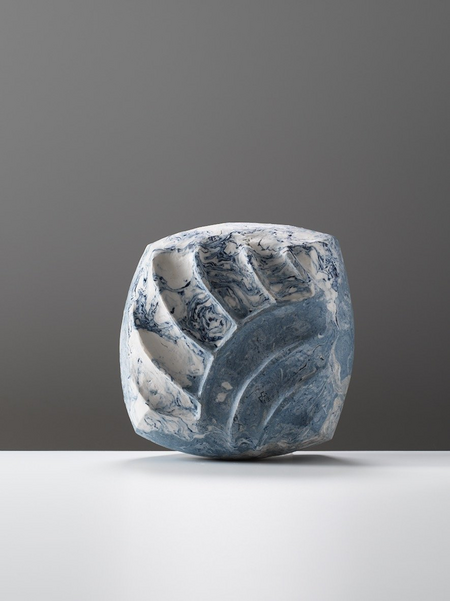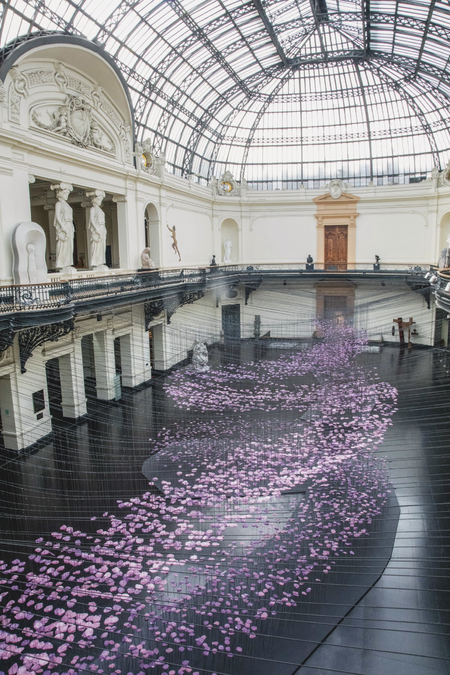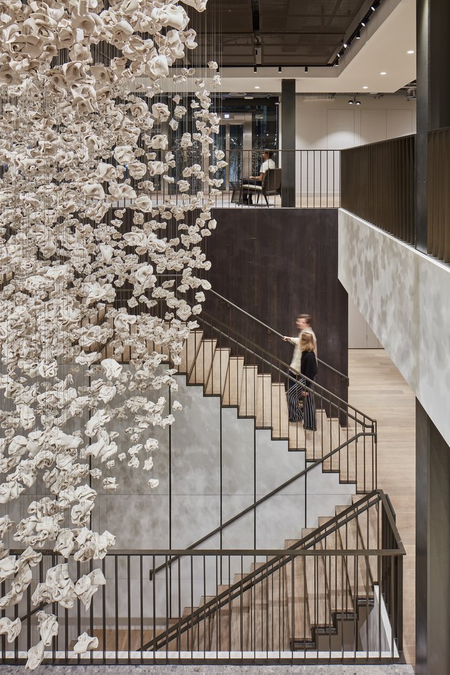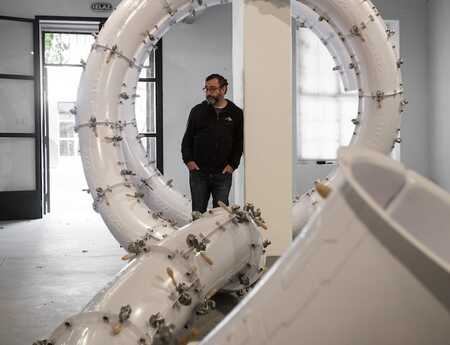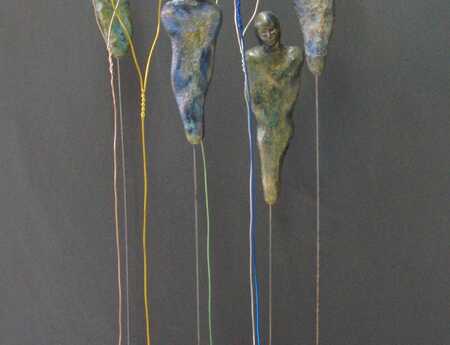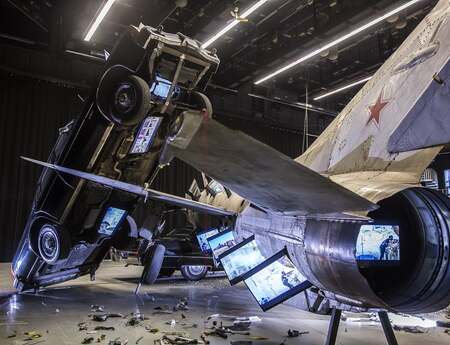"Entweder ausweichen oder sich damit auseinandersetzen" – Fernando Casasempere
Fernando Casasempere (geb. 1958 in Santiago de Chile, lebt in London) arbeitet mit Ton, Keramik und Kunststoffen und lotet die verwendeten Möglichkeiten für die zeitgenössische Bildhauerei aus. Casasempere ist fasziniert von den Spuren, die der Mensch auf der Erde hinterlässt, und greift auf Archäologie, Geologie, Landschafts- sowie klassische und moderne Architektur zurück, um skulpturale Archetypen zu unterlaufen. Dabei spricht er, vor dem Hintergrund seiner chilenischen Heimat, drängende globale ökologische und soziale Anliegen an.
Fernando Casasempere hat ein arbeitsreiches Jahr hinter sich: die Einzelausstellungen Terra im San Diego Museum of Art und Scratching the Surface im Bloomberg SPACE, die Auswahl für die Auswahlliste des Loewe Prize aus mehr als 3.000 Einsendungen und die Enthüllung zweier großer neuer Auftragsarbeiten im Henrietta House und im Soho Place. Ich habe ihn interviewt, um mit ihm über seine künstlerische Praxis, seine Beziehung zur Bildhauerei und darüber zu sprechen, warum dieses Medium so geeignet ist, einige der drängendsten gesellschaftlichen und ökologischen Fragen unserer Zeit anzusprechen.

Ihre Arbeit befasst sich mit einigen der drängendsten Fragen unserer Zeit, Klimawandel, Plünderung der natürlichen Ressourcen und unsere Beziehung zur Erde. Inwiefern ist die Bildhauerei so geeignet, diese Themen anzusprechen? Was kann die Bildhauerei heute leisten?

Ich meine, dass es eher die Kunst als die Skulptur selbst ist, die das Privileg hat, eine Stimme zu haben - wie jetzt, wo Sie mich interviewen. Und ich denke, dass sich die Kunst zu diesen sehr wichtigen Themen äußern muss, um das Bewusstsein zu schärfen. Ich bin ein eher „dreidimensionaler“ Mensch, daher denke ich, dass die Bildhauerei in gewisser Weise mich gewählt hat und ich die Bildhauerei gewählt habe, um über diese Themen zu sprechen. Aber ich glaube, es hat etwas mit der Präsenz der Skulptur zu tun und mit den Möglichkeiten, die dreidimensionale Objekte bieten. Denn man kann sich darauf einlassen wie bei einigen Räumen meiner jüngsten Ausstellung Terra im San Diego Museum of Art (2022). Man geht durch die Idee hindurch, man ist an der Idee beteiligt. Es schafft Resonanz, weil es eine physische Sache ist - es gibt eine physische Reaktion. Deshalb glaube ich, dass, wenn sich die Leute über Graffiti in der Stadt beschweren, es daran liegt, dass es auch die Wege der Menschen unterbricht. Und genau darum geht es auch bei der Skulptur. Sie ist physisch präsent, und die Menschen können dann wirklich interagieren: Sie müssen entweder ausweichen oder sich damit auseinandersetzen. Man kann die Menschen also im Wortsinne vor eine Idee stellen oder in sie eintauchen lassen, und zwar auf eine Weise, die bei anderen Medien vielleicht weniger direkt ist.
Sie ziehen oft einen Vergleich zwischen der Geologie und Ihrer Arbeit als Künstler. Ich würde gerne mehr darüber erfahren.
Das stimmt schon, ich habe in letzter Zeit darüber nachgedacht, warum Geologie für mich so wichtig ist. Ich komme aus einem Land, in dem es unglücklicherweise die meisten Erdbeben auf diesem Planeten gibt. Soweit ich weiß, gibt es in Chile über 40 aktive Vulkane. Diese Präsenz der Geologie, des geschmolzenen Materials in den Vulkanen, die Lebendigkeit der Erde, begleitet mich und ist seit meiner Geburt ein Teil von mir. Wenn man in Chile lebt, hört man immer von den tektonischen Platten, den amerikanischen Platten. Es gibt eine solche Plattentektonik auch im Zentrum von Santiago, wir sind also unglaublich eng mit all dem verbunden. Und wo ist die Verbindung zu dem, was ich zu tun versuche? Meiner Meinung nach können sich die Europäer das am ehesten beim Fracking vorstellen. Was kommt Ihnen in den Sinn, wenn Sie an Fracking denken? An das, was darunter ist, an den Kern, an die Schäden, die im Inneren entstehen. Wir beschädigen und zerstören die Erde, und die Erde zittert daraufhin. Wenn ich an Fracking denke, habe ich das gleiche Gefühl wie bei tektonischen Platten oder den Erdbeben in Chile. Es versetzt einen sofort in das Innere des Planeten.
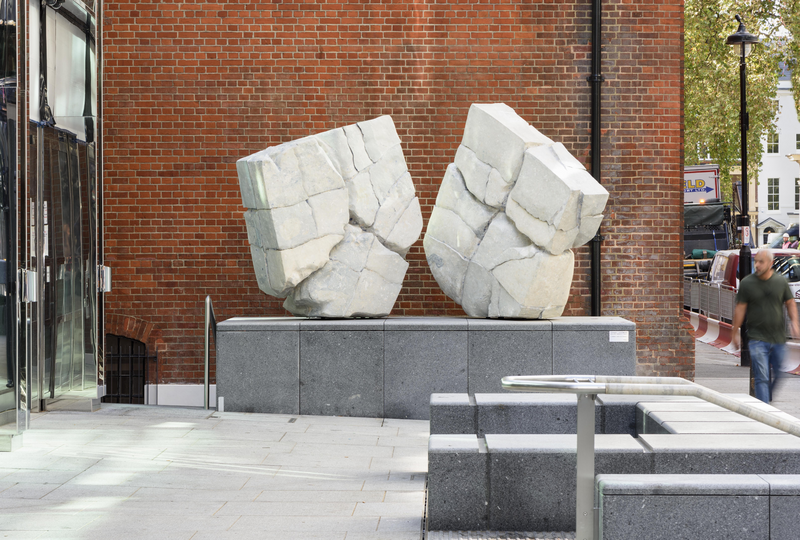
Vulkane sind die größten Keramiker, denn die Kraft des Feuers, das in ihnen geschmolzen ist, konzentriert sich im gesamten Magma, das nichts anderes ist als all die Mineralien, die aus der Hitze des Zentrums, des Kerns des Planeten stammen. Und von Zeit zu Zeit explodiert der Vulkan, er schickt alles hinaus, und wenn es erkaltet und sich verfestigt, wird es zu einem neuen Material, einem neuen Gestein, einem neuen Mineral. Und genau das tun wir auch mit Keramik - mein neues Werk um die Ecke des Bahnhofs Tottenham Court Road heißt Geology Rebuilt (2022). Als Bildhauer, der mit Keramik arbeitet, pulverisiere ich all diese Mineralien zu einem Gemisch, das aber immer noch Eisen und alle möglichen Bestandteile enthält, und lege sie dann neu konfiguriert ins Feuer. Wenn der Ofen abkühlt, wird diese Mischung zu etwas anderem; sie wird zu dieser neuen Geologie, diesem neuen Material. Deshalb vergleiche ich das, was ich tue, mit Vulkanen, und kann mit Recht behaupten, dass sie die besten Keramiker der Welt seien.

In Ihrer Arbeit spiegelt sich eine tiefe Verbundenheit mit der Landschaft Ihres Heimatlandes Chile wider, die sich auch materiell in Ihren Werken niederschlägt. Ich würde gerne mehr über Ihr Tongemisch erfahren und was Sie dazu veranlasst hat, Abfallstoffe zu verwenden?
Als ich angefangen habe, mit Ton zu arbeiten, habe ich eine sehr bewusste Entscheidung getroffen: Ich wollte zu den Meistern meines Kontinents gehören, ich wollte den Meistern der amerikanischen Ureinwohner meines Kontinents meinen Respekt zollen. Ich wollte Ton zum Sprechen bringen, und zwar auf eine wirklich zeitgenössische Art und Weise und bis an die Grenzen des Mediums gehen. Deshalb macht es mir auch so viel Freude, Werke wie Geology Rebuilt (2022) oder andere große Projekte zu machen, weil sie einen wirklich an die Grenzen des Möglichen bringen. Um diese Art Ideen zu verwirklichen, muss man umgestalten und neu denken und versuchen, das Unmögliche möglich zu machen - ein 200 kg schwerer massiver Porzellanblock zum Beispiel sollte eigentlich unmöglich sein, aber er wurde angefertigt. Um das zu erreichen, muss ich erst Tausende von Tests durchführen - nicht nur die Materialien testen, sondern auch die Temperatur des Ofens, wie schnell sie steigen oder fallen kann, all das. Alles begann 1991, als ich ein Stipendium erhielt, um den Umgang mit neuen Materialien zu erlernen und diese in den Ton einzubauen. Und dann bin ich nach Chile gereist, und wie Sie wissen, ist Chile ein Land der Mineralien: Es ist reich an Kupfer, Eisen, Lapislazuli und Lithium. Es ist in dieser Hinsicht sehr gesegnet, aber jetzt, mit einem neuen Bewusstsein, müssen wir uns diesen Materialien auf eine andere Weise nähern. Und ich überlegte, dass diese Materialien bereits so bekannt sind. Wie wäre es, wenn ich den Abfall, das Nebenprodukt der Gewinnung dieser Mineralien, die Konsequenz des Extraktivismus, nutze, um die Diskussion über unsere kollektive Verantwortung, Lösungen für die Klimakrise zu finden, neu zu gestalten?

Könnten Sie etwas mehr über das Thema Extraktivismus in Chile sagen und wie es Ihre Arbeit und Praxis beeinflusst hat?
Das ist eine komplexe Frage. Meiner Meinung nach gibt es dort eine ganz andere Sichtweise als in den sogenannten entwickelten Ländern der ersten Welt. Um den Extraktivismus in Chile zu verstehen, ist es wichtig, ihn in einen Kontext zu stellen: Wir sind einerseits eines der Länder mit den geringsten Umweltauswirkungen auf die Erde, und wir sind andererseits eines der Länder, das am meisten vom Klimawandel betroffen sein wird. Können wir es uns also leisten, nicht zu fördern, nicht zu nutzen, was wir haben? Welche sozialen Auswirkungen hat das? Sieht man die Armut und den daraus resultierenden Mangel an Mitteln zur Bildungsfinanzierung mit allen Konsequenzen, die das mit sich bringen würde? Für mich lautet die Antwort: Zusammenarbeit. Das Bewusstsein schärfen und bessere, klimaeffizientere Methoden finden. Vor allem aber müssen sich die Länder der ersten Welt bewusstwerden, welchen Schaden sie dem Planeten zugefügt haben. Wir müssen ein Gleichgewicht finden, und ich hoffe, dass das Reden darüber und die Beantwortung von Fragen Raum für ein echtes Gespräch schaffen können.
Es gibt ein großes ökologisches Paradoxon - wir versuchen, eine grüne, auf erneuerbaren Energien basierende, batteriebetriebene Zukunft anzustreben, um Öl und Gas zu ersetzen, aber natürlich arbeiten diese Batterien mit Mineralien, die abgebaut werden müssen, um diese grüne Revolution voranzubringen. Und diese Prozesse werden wahrscheinlich verheerende Folgen für die Umwelt und auch für die sozialen Auswirkungen haben. Wie können wir also vom Öl und vom Gas wegkommen - von denen wir unbedingt wegkommen müssen - und neue Alternativen finden, ohne die Fehler der fossilen Wirtschaft zu wiederholen?
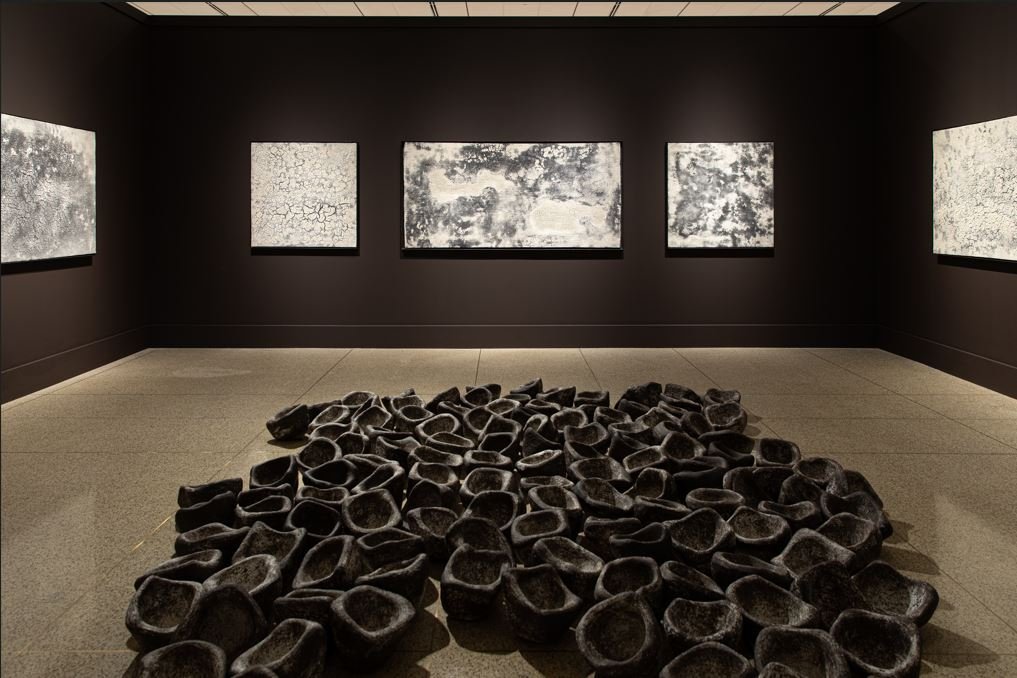
Ja! Die Richtung, in die wir gehen müssen, bedarf hierzu einer neuen Gesellschaft, in der wir weniger tun, weniger produzieren müssen. Wir müssen langlebige, qualitativ hochwertige Dinge herstellen, die wir nicht alle 5 oder 10 Jahre ersetzen müssen. In den 1950er Jahren funktionierten Haushaltsgeräte zwanzig Jahre lang. Heute wird die geplante Obsoleszenz bei allem berücksichtigt - sonst würde der Kapitalismus, der das Krebsgeschwür des Planeten ist, auch nicht wachsen. Es geht also auch darum - das Wachstum zu bremsen. Lassen Sie die ärmeren Länder sich mit Bedacht entwickeln, aber denken Sie auch an einen neuen Ansatz, bei dem die größeren, reicheren Länder den Planeten nicht missbrauchen.
Zurück zur Bildhauerei: Einige Werke, wie die Ihrer Wandarbeiten aus der Salares-Serie, verschieben die Grenzen dessen, was mit Materialien wie Ton möglich ist, und damit auch die Parameter dessen, was wir als Bildhauerei wahrnehmen und anerkennen. Können Sie mir mehr über Ihre Experimente in der zweiten und dritten Dimension erzählen?
In erster Linie bin ich Künstler, und als Künstler muss ich forschen, mich weiterentwickeln und verändern. Ich möchte mein Material zum Sprechen bringen. Deshalb verwende ich rohen Ton, um etwas Neues zu schaffen, und ich möchte den Ton auf die umfassendste Art und Weise verwenden: roher Ton, Porzellan, Steingut, Niedertemperaturton, glasiert und unglasiert. Und zweitens, da ich mich zu einem großen Teil von der Landschaft meines Landes inspirieren lasse, möchte ich über die Salinen sprechen, ich möchte über die Oberfläche des Planeten sprechen, nicht nur über die Geologie, nicht nur über den Kern oder das Innere. Das waren für mich die Hauptmotivationen für diese Serie, ebenso wie der Versuch, in zwei Dimensionen zu forschen. Wenn ich mich in gewisser Weise in den Bereich der Malerei begebe, bereichert das meine Arbeit insgesamt, und schlichter Dings freue ich mich darauf, morgens aufzustehen und etwas Neues auszuprobieren.
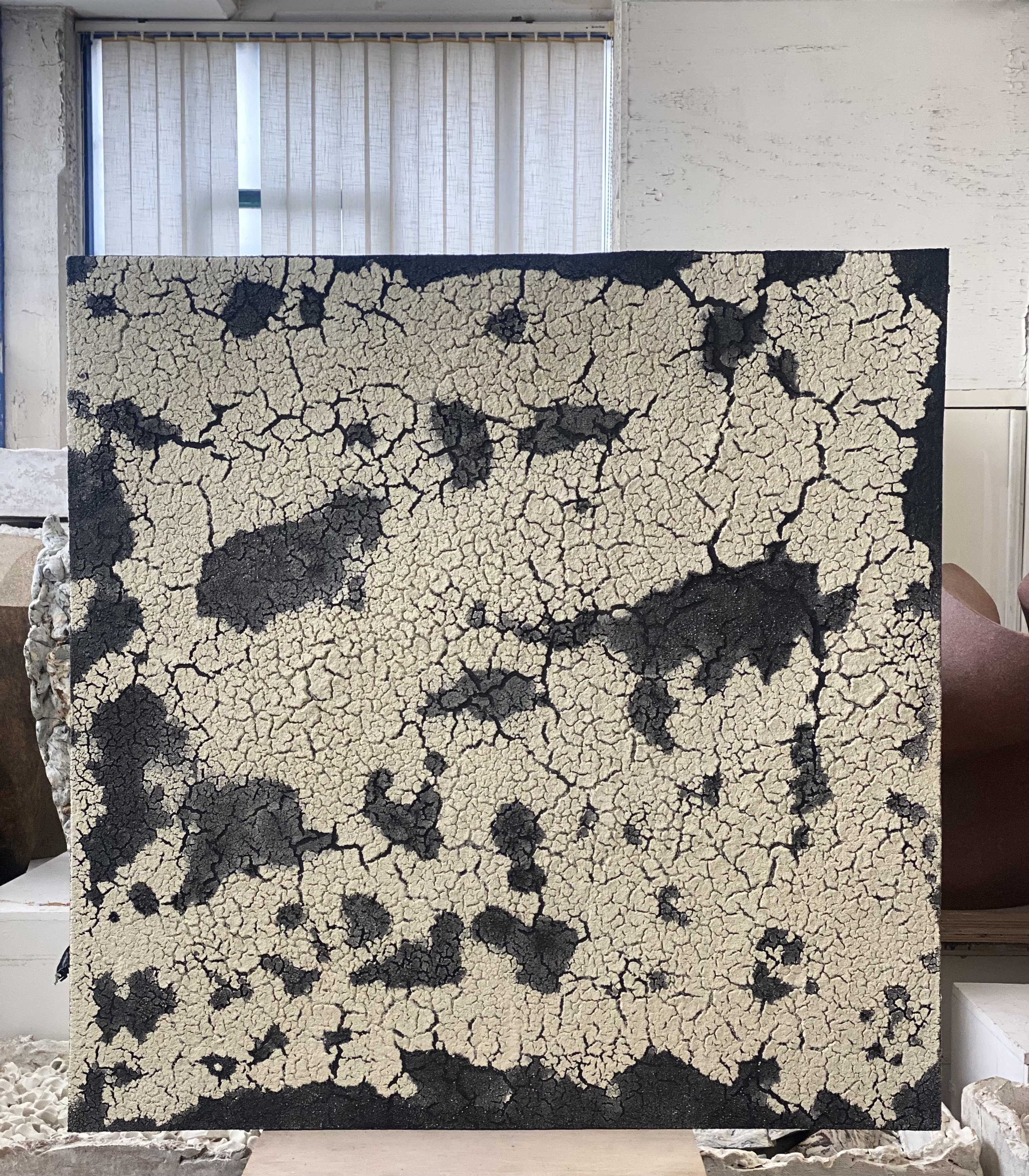
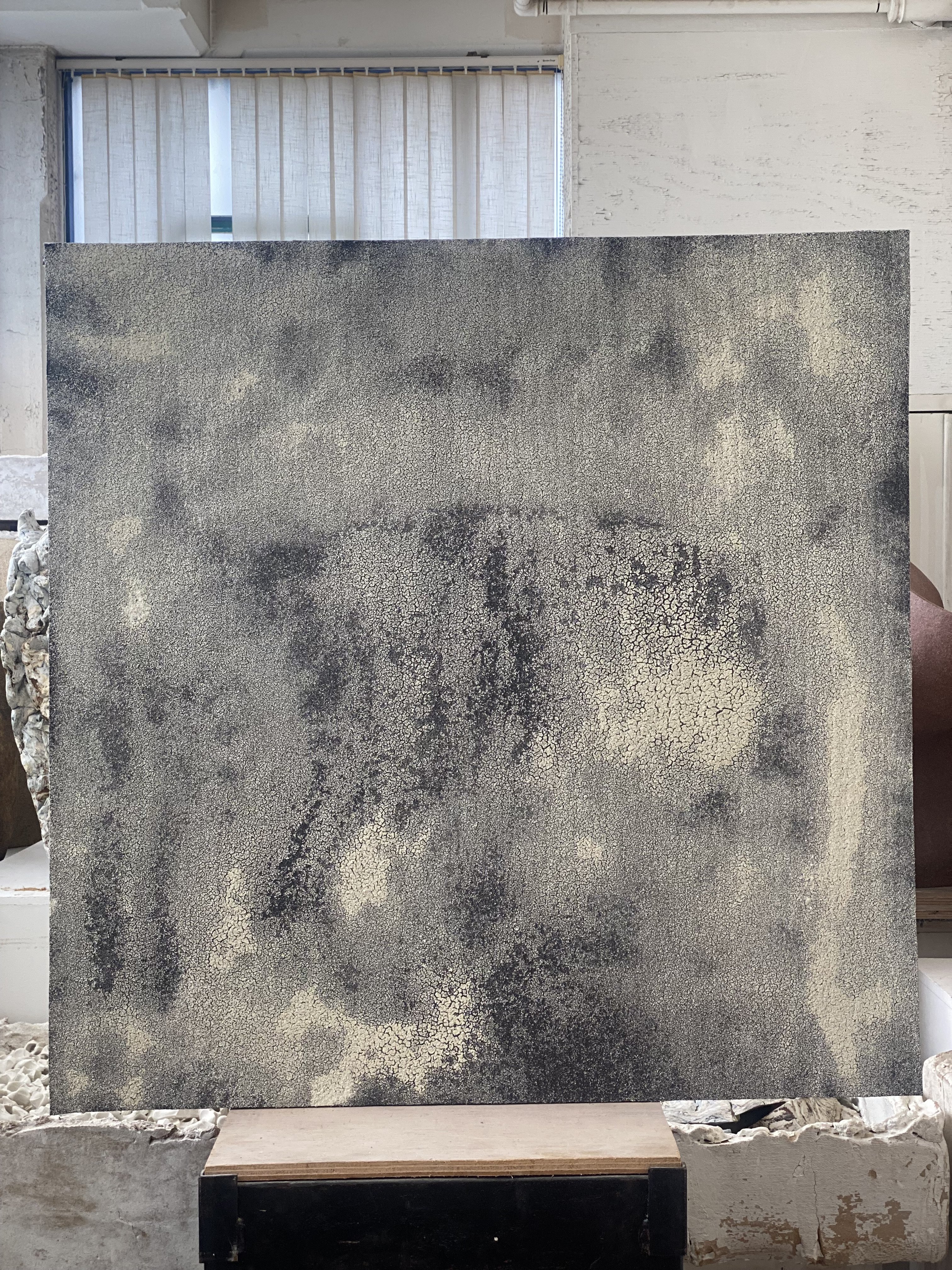
Fernando Casasempere, Salar, 2022. Clay and India ink on felt
Und wie Sie bereits gesagt haben, bereichert der Übergang zu einer fast malerischen Dimension den bildhauerischen Prozess, weil er die Frage aufwirft, was Bildhauerei sein kann.
Genau. Und ehrlich gesagt kann man an dieser Serie sehen, wie bildhauerisch ich wirklich bin, denn meine „Malerei“ als solche ist sehr materiell, und obwohl sie zweidimensional ist, ist sie geschichtet und dick, und es gibt die Materialität von Filz und Keramik. Materie und Materialien haben mich seit meinem zehnten Lebensjahr sehr angezogen. Wenn ich ins Museum ging, blieb ich immer vor den Gemälden von Tàpies und ähnlichen Künstlern stehen, weil sie so unglaublich reich an Material sind.
Ja! Er ist ein gutes Beispiel für einen Künstler, dessen Gemälde eher Skulpturen als Gemälde sind. Und damit hängt zusammen, dass Keramik normalerweise nicht mit Bildhauerei in Verbindung gebracht wird und historisch gesehen in den Bereich des Handwerks oder des Designs verwiesen worden ist. Wie begann Ihr Interesse an der Keramik, und was hat Sie dazu bewogen, sich diesem Material zuzuwenden, um Ihre bildhauerischen Werke zu schaffen?
Alles begann, als ich in jungen Jahren präkolumbianische Kunst sah. Für mich war es ein unglaubliches Material, das mir verstehen half, was die indigenen Völker Amerikas erreicht haben. Aber das Interessanteste ist, dass sie kein Problem mit der Unterscheidung zwischen einem Gefäß und einer Skulptur hatten. Für sie ist ein Gefäß an sich schon eine Skulptur. Sie machten Gesichter auf Gefäßen oder zoomorphe Formen, sie machten Porträts ihrer Leute auf den Gefäßen - die Inkas ebenso wie die Mayas. Ich habe also nie die Skulptur vom Gefäß trennen können und würde das auch nie tun. Für mich gehören die beiden zusammen. Die Herausforderung bestand für mich darin, etwas anderes zu machen. Ich kann ihnen huldigen, aber mit meiner eigenen bildhauerischen Sprache. Ich bin offensichtlich kein Ureinwohner, aber ich habe enormen Respekt vor ihren ästhetischen Traditionen und das Gefühl, dass ich von diesen Bildsprachen eine Menge lernen kann. Vieles von dem, was sie vor so langer Zeit gemacht haben, ist in der zeitgenössischen Kunst nicht mehr zu finden. Und als ich mich entschloss, Kunst zu studieren und einen Prozess der Intellektualisierung durchlief, wurde mir klar, dass ich Teil dieser Traditionen bin und nicht vom weißen Marmor komme, den ich studierte. Das hat mich darin bestärkt, wie wichtig die Keramik ist und wie ich die Bildhauerei angehen sollte.
Künstler, die sich mit Bildhauerei beschäftigen, lassen sich oft von klassischen europäischen Traditionen inspirieren. Sie hingegen zelebrieren in Ihrer künstlerischen Praxis die präkolumbianische Kunst. Bitte erzählen Sie mehr über die Einflüsse, die Sie zur Entwicklung Ihrer Ästhetik geführt haben.
Die präkolumbianische Kunst ist einer meiner größten Einflüsse. Aber wenn man über präkolumbianische Kunst in Lateinamerika spricht, ist das ein politisches Thema. Die indigene Bevölkerung im Süden Chiles protestiert, um ihr Land zurück und in der Verfassung rechtlich verbrieft zu erhalten. Die Menschen außerhalb dieser Sphäre sind nicht daran interessiert, sich mit den indigenen Wurzeln des Landes auseinanderzusetzen und auch das reiche künstlerische Erbe anzuerkennen, das wir von den indigenen Völkern Chiles haben. Die Menschen fühlen sich damit unwohl. Und das ist einer der größten Fehler. Deshalb möchte ich ganz bewusst über präkolumbianische Kunst und den enormen Einfluss, den sie auf meine Praxis hatte, sprechen, denn wir müssen diese Traditionen anerkennen. Die indigenen Völker sind Meister in der Kunst und in vielen anderen Dingen, in ihrem Umgang mit der Gesundheit und der Nutzung des Planeten. Wir müssen von den indigenen Völkern lernen.
Wie ich während meines Studiums gelernt habe, ist das Erstaunliche an der präkolumbianischen Kunst, dass sie eine der unverfälschten Ausdrucksformen der Welt ist. Denn zu dieser Zeit hatten ihre Schöpfer keine Kenntnis von anderen Zivilisationen. Die Mittelmeerzivilisationen beispielsweise wussten von anderen Zivilisationen. Eines der besten Beispiele dafür ist Venedig - mit seinen Überschneidungen mit dem byzantinischen Reich und römischen Einflüssen. Aber die Kunst der Präkolumbianer war so einzigartig, weil sie nur von ihnen selbst stammte. Als mir das klar wurde, war ich sehr beeindruckt. Aber als ich anfing, Keramik zu studieren, dachte ich, ich müsste Chile verlassen, denn Keramik ist nichts, was man in Chile lernt oder macht, und zwar aus vielen der genannten Gründe. Und alles, was mit indigenen Praktiken zu tun hat, wird immer noch als weniger wertvoll angesehen; es wird nicht gefeiert und nicht gelehrt. Das hat zur Folge, dass wir in Chile keine gute Keramikschule haben. Ich hatte das Gefühl, dass ich Chile verlassen musste, aber gleichzeitig wollte ich nicht zu viel europäische Kunst studieren, weil ich nicht von dieser Zeit beeinflusst werden wollte. Als ich dann aus Chile wegzog, begann ich später, einige europäische Referenzen einzubringen. Aber die präkolumbianische Kunst geht mir immer wieder durch den Kopf.
Ton scheint in der Welt der zeitgenössischen Bildhauerei und der zeitgenössischen Kunst im Allgemeinen ein Comeback zu erleben - warum glauben Sie, dass dies gerade jetzt geschieht? Warum gibt es ein erneutes Interesse an Ton?
Ich denke, das liegt daran, dass die Kunstwelt sich selbst überprüft und mit sich selbst abrechnet. Ich glaube, dass sich lange Zeit das Material und die Künstler, die damit arbeiten, etwas zurückgesetzt fühlten. Und historisch gesehen wurden die Medien in der Kunstgeschichte ebenso wie die Menschen in den Hintergrund gedrängt. Sehen Sie sich zum Beispiel an, was mit dem weiblichen Geschlecht passiert ist. Plötzlich erkannte das Kunstestablishment die Bedeutung von Künstlerinnen und die Ungerechtigkeit einer Kunstgeschichte ohne Frauen. Ich denke, dass die Anerkennung von Ton jetzt Teil einer Revision ist. Und ich hoffe, dass es sich wirklich um eine ernsthafte Revision handelt und nicht nur um einen Markttrend, wie er in der Kunstwelt häufig vorkommt und ziemlich gefährlich sein kann.
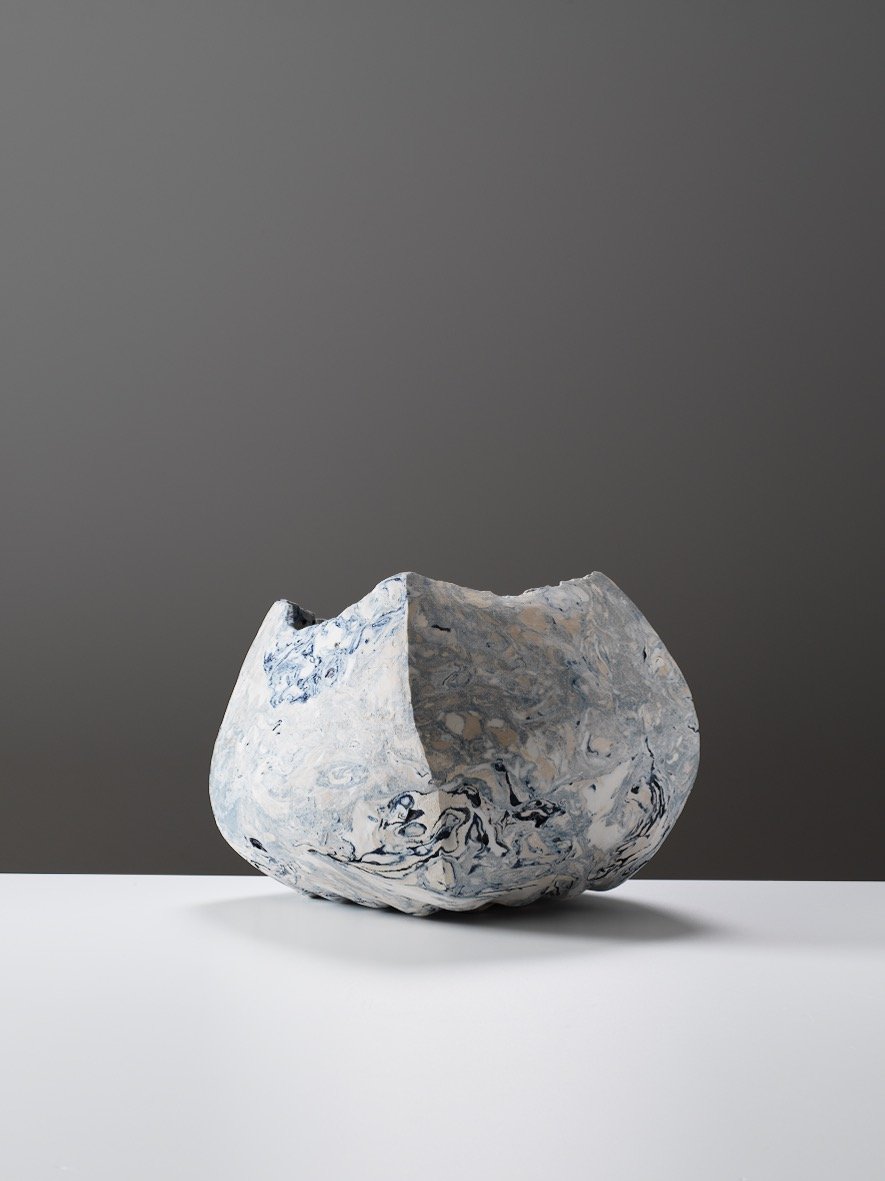
Fernando Casasempere, Vessel (ripple), 2019. Courtesy of the artist
Sie haben schon einmal über den Topf gesprochen - das elementarste Stück, das ein Keramiker herstellt - als Ihre Version eines Aquarells. Ich liebe diese Analogie - können Sie mir mehr darüber erzählen?
Ich sage oft, dass wir das Gefühl haben, die Unterscheidung zwischen Kunst und Handwerk ständig verteidigen oder rechtfertigen zu müssen, und ich habe das Gefühl, dass diese Verteidigung in der Vergangenheit nicht sehr überzeugend war, dass den Leuten nicht daran gelegen war, das Material und seine Würde zu verteidigen. Wenn ein Maler sich mit allen Aspekten seines Mediums befasst, wird das Gesamtwerk interessanter. Für mich ist es genau dasselbe, und das ist es, was ich erreichen möchte. Ich experimentiere mit Temperaturen, mit der Maßstälichkeit, ich habe Geschirr gemacht, alles. Wir denken heute nicht mehr so oft darüber nach, aber es war ein enormer Schritt für die Zivilisation, als der Mensch die Schale herstellte, die die Nahrung von der Erde trennte; es gab weniger Krankheiten, weniger Infektionen. Warum feiern und würdigen wir das nicht? Und deshalb sage ich, dass der Topf mein Aquarell ist. Fragen Sie mich nicht, ob ich Keramiker oder Bildhauer bin: Ich arbeite mit Ton und möchte alle Aspekte des Tons erforschen. Meine skulpturalen Blöcke, die wirklich große Stücke sind und eine Tonne wiegen - bei diesen Arbeiten spreche ich von Ziegeln! Von Ziegeln und Mörtel und anderen sehr wichtigen Anwendungen des Materials. Ziegel sind Keramik, und ich schäme mich nicht, diese Verbindung deutlich zu machen.
Diese binären Unterscheidungen zwischen Keramik und Skulptur, Kunst und Handwerk - sie sind nicht mehr besonders nützlich, sie sind unglaublich reduktiv.
Dem stimme ich zu. Der Unterschied ist für mich die Qualität. Peinlich wäre mir ein schlechter Topf. Oder eine schlechte Skulptur. Und das eine hat das andere nicht berührt oder mit dem anderen verbunden. Wir haben uns ziemlich lange gescheut, die unendlichen Möglichkeiten von Ton zu erforschen. Und ich glaube, wenn die Leute damit anfangen, dann reagiert die Kunstwelt darauf. Denn es geht darum, Grenzen zu überschreiten, weiterzugehen. Wie Michelangelo sagte, als er die Nase einer seiner zu perfekten Skulpturen zertrümmerte und zu ihr sagte: „Sprich!" Das ist unsere Herausforderung, das ist unsere Pflicht. Wir müssen das Material zum Sprechen bringen, und zwar auf unterschiedliche Weise.

Mich interessiert die Art und Weise, wie Ihre Serie "Vessels (Organic forms)" - die für den diesjährigen Loewe-Preis nominierte -, einen direkten Bezug zum Körper hat, obwohl sie nicht anthropomorph ist. Wie gehen Sie bei diesen Arbeiten vor? Was denken Sie: Kann die Bildhauerei zu unserem Verständnis von Raum und unserem Körper im Raum beitragen?
Für diese Arbeiten mache ich einen großen Ballon, jeder hat eine andere Form, und dann, wenn die Konsistenz stimmt, nehme ich meinen eigenen Körper und beginne, den Ton zu komprimieren und dann zu schnitzen: Ich mache eine tiefere Kurve oder übertreibe die Stelle, an der ein Teil des Ballons in den Raum hinausgeht. Dann beginnt das Gespräch zwischen dem Künstler und dem Stück. Und ich entwickle diese Stücke weiter, weil sie mir wirklich Spaß machen und es noch viel zu entdecken gibt. Diese Perfektion oder Mischung zwischen dem Nützlichen, der Resonanz von Gefäßen und Skulpturen und der Perfektion, wenn man den Körper benutzt. Es gibt etwas an der Größe des Körpers, das die Proportionen fast perfekt macht. Und das gefällt mir sehr gut. Und gleichzeitig versuche ich, durch den Einsatz des Körpers beinahe die Beziehung zwischen dem Körper und einem Griff herzustellen. Oder wie bei den Skulpturen von Heiligen, wo die Leute die Skulptur an einer bestimmten Stelle berühren, und einen Abdruck machen, und die Patina ist weg. Genauso ist es, wenn man den Griff eines Gefäßes oder Kruges berührt - es gibt einen direkten Kontakt, eine direkte Beziehung zwischen dem Körper und dem Stück.

Ihr Werk oszilliert zwischen groß angelegten Installationen - wie Out of Sync (2012) im Somerset House oder Ihre monumentale Installation im Bellas Artes Museum (2016) in Chile sowie Murmurations (2022), eine Arbeit, die kürzlich im Henrietta House in London installiert wurde - und kleinen, intimen Arbeiten. Oft bestehen Ihre größten Skulpturen aus winzigen Einzelteilen, vielen kleinen Stücken, die ein Ganzes ergeben. Was gefällt Ihnen am Spiel mit dem Maßstab?
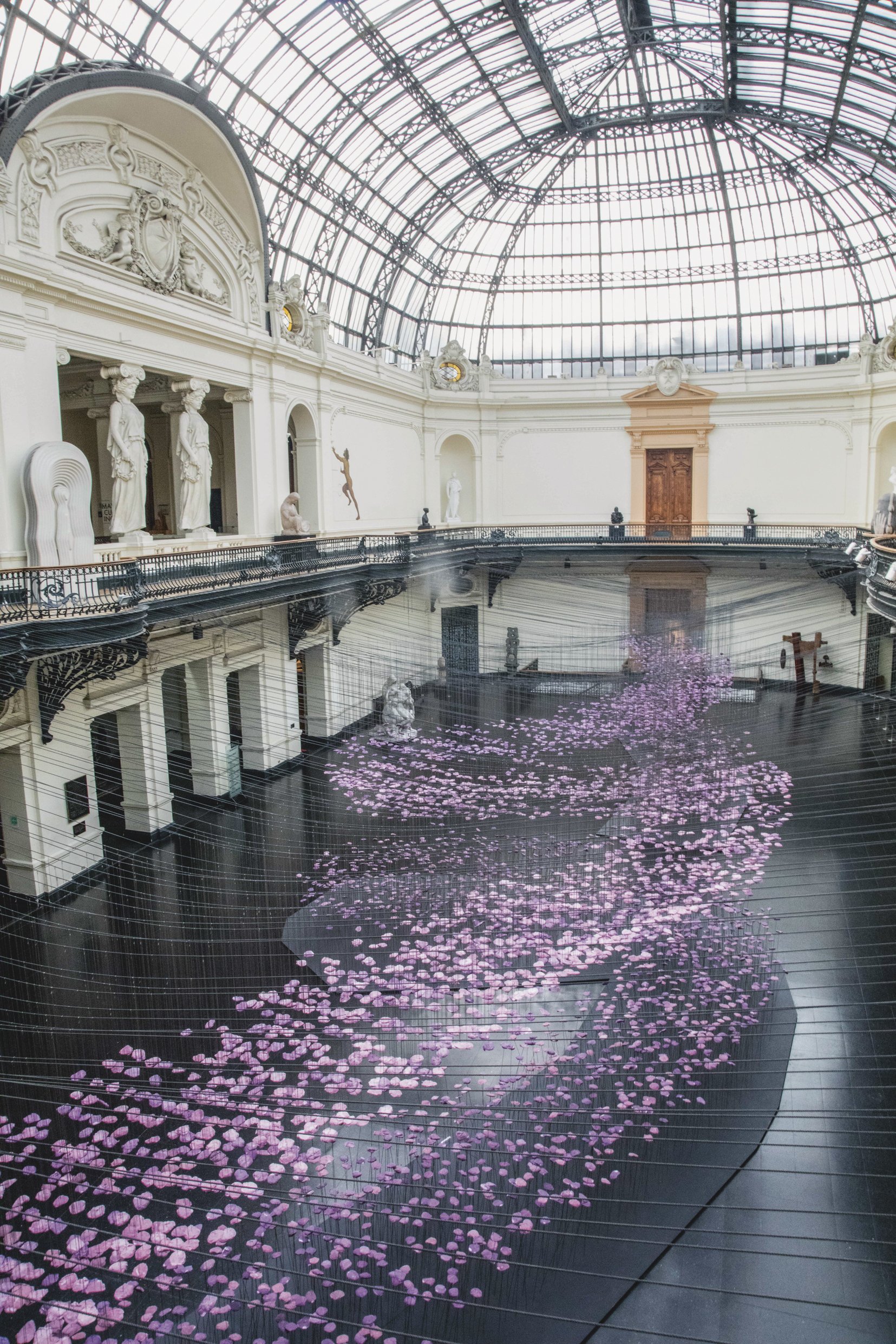
Es macht mir Spaß und ist gleichzeitig ein Lernprozess. Denn wenn ich an diesen sehr intimen kleinen Stücken arbeite wie einem Würfel von 10 x 10 cm, dann merke ich, wie sehr mein Nacken schmerzt, während ich arbeite! Man ist wirklich in dem Stück drin, man hat es in der Hand, also ist die Herangehensweise eine ganz andere. Und dann erinnere ich mich, als ich das Stück für das Somerset House (Out of Sync, 2012) machte, das aus 10.000 einzelnen Keramikblumen bestand, hatte ich eine Art Aha-Erlebnis - bis dahin hatte ich jedes Stück wie ein Einzelstück behandelt. Aber dann dachte ich, ich muss über das Ganze nachdenken: Also begann ich, jede Blume in verschiedene Richtungen zu perforieren, um ihr einen Stiel hinzuzufügen, so dass sie als Gruppe in Bewegung ist. Und diese Momente sind eine enorme Bereicherung für meine Praxis. Und es ist lustig, ich sage immer, dass jedes Material seine eigene Größe hat. Ein Aquarell zum Beispiel, das 2 m x 4 m groß ist - das sieht man selten, ich bin mir nicht sicher, ob es das gibt. Und ich glaube, das liegt daran, dass das Material eine Stimme hat, jedes Material hat einen Maßstab. Mit Keramik ist es dasselbe - das ist die Logik des Ziegels. Man kann die Elemente multiplizieren, um einen Maßstab zu schaffen. Die Technik des Brennofens, die Größe, die er ermöglicht, all das muss im Einklang oder im Gespräch mit dem Material sein.
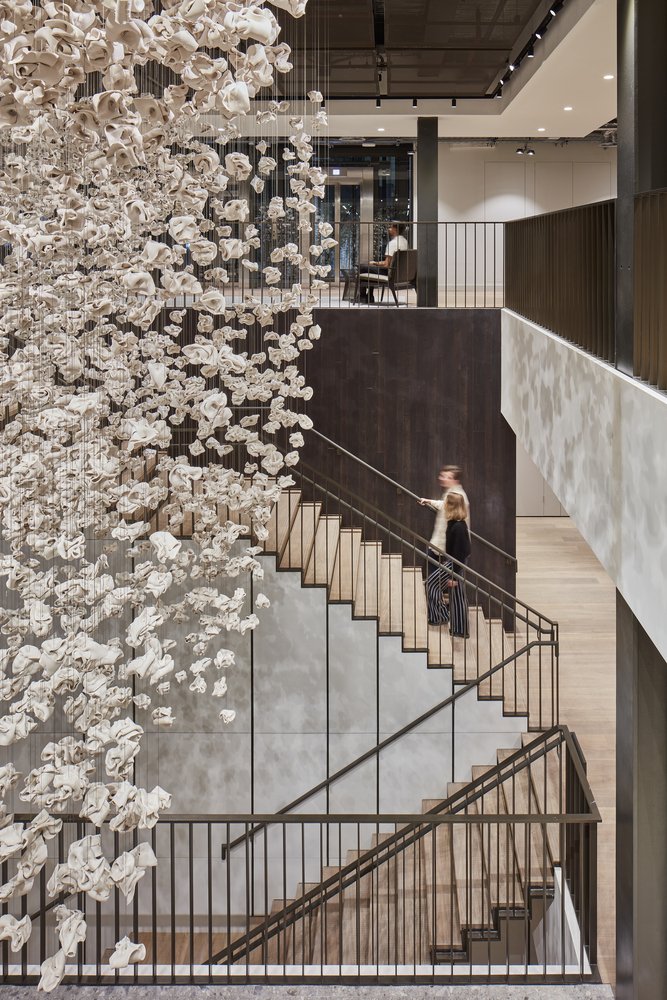
Ich arbeite gerne sowohl an großen als auch an kleinen Skulpturen. Diese monumentalen Werke, diese großformatigen Arbeiten, entstehen normalerweise aus einem Auftrag oder einer Einladung heraus. Mir gefällt daran, dass sie einen in eine Lage versetzen, die man nie erwartet hätte. Wie bei Somerset House - ich hätte nie im Leben gedacht, dass ich einmal Blumen machen würde. Aber ich habe es getan. Denn Blumen sind ein sehr brisantes Thema - wie Maler, die versuchen, einen Lichtstrahl zu malen. Aber für diesen speziellen Ort hielt ich es für das Beste, Blumen zu verwenden, um über das zu sprechen, was ich ansprechen wollte: eine Erde und ein Klima, die nicht mehr miteinander im Einklang sind. Es ist also wirklich interessant, wenn man sich in ein völlig anderes Szenario begibt, als man es aus seiner normalen Praxis kennt. Und dann ist es auch interessant zu sehen, wie die Leute darauf reagieren, denn es ist definitiv öffentlicher. Aber ich mag auch die intimen Arbeiten - wenn ich diese riesigen Projekte mache, die manchmal ein paar Jahre dauern, fange ich an, meine andere Arbeit im Atelier zu vermissen! Alles bereichert einander, so denke ich darüber.
Wenn Sie die Bestandteile eines riesigen Werks herstellen, wie bei Ihrer Arbeit im Somerset House - wie ist dieser Prozess psychologisch zu verstehen? Er beinhaltet viele Wiederholungen, und ich frage mich, ob Sie ihn als eine Art Meditation erleben?
Es ist definitiv eine Art Meditation. Ich mag diese kontinuierliche Wiederholung, und als ich das im Atelier erforschte, war das in gewisser Weise ein Moment, in dem mir ein Licht aufging, was meine gesamte Idee für diese spezielle Installation (Out of Sync, 2012) veränderte. Das ist die Art von Stille und Meditation, in die man sich begibt, wenn man diese kleinen Teile wiederholt, um ein größeres Ganzes zu schaffen. Und ich glaube, weil ich das tat, wurde mir klar, dass es nicht um die Blume geht - es geht um die gesamte Wiese.

Woran arbeiten Sie gerade im Atelier?
Im vergangenen Jahr war ich viel auf Reisen, und meine Arbeit hat viel Aufmerksamkeit erhalten, darunter eine große Einzelausstellung im San Diego Museum of Modern Art (Terra, 2022). Ich bin dankbar für all diese Gelegenheiten, aber ich vermisse auch meine Routine, meine Zeit im Atelier, um eine Idee weiterzuverfolgen. Also mache ich jetzt neue Stücke. Ich verfolge bestehende Themen, aber auf ganz andere Weise. Kürzlich habe ich versucht, eine neue Farbe mit dem Ton herzustellen. Für mich ist eines der interessantesten Dinge der Dialog mit dem Material und die Art und Weise, wie Farbe und Textur in der Keramik helfen, eine Idee zu vermitteln. Ich fühle mich wie ein Kunsthandwerker, wenn ich immer wieder dasselbe tue. Natürlich muss man innehalten und eine Idee entwickeln, bis man sie beherrscht. Aber sagen wir mal, ich fühle mich mit Ai Wei Wei mehr verbunden als mit anderen Künstlern - in dem Sinne, dass er immer experimentiert, aber auf ganz unterschiedliche Weise: von den Fahrradskulpturen bis hin zu den Skulpturen mit Möbeln... Das gefällt mir sehr, und ich sehe mir sehr gerne Arbeiten von Künstlern wie ihm an. Ich fühle eine Art Verwandtschaft mit ihm, aber der Unterschied ist natürlich, dass ich nur ein Material verwende und all seine verschiedenen Facetten erforsche: Das ist meine große Aufgabe.
Über den Künstler
Casasempere wurde durch zahlreiche Ausstellungen bekannt. Seine Werke befinden sich in Sammlungen wie dem Victoria & Albert Museum, London, dem Museum of Fine Arts, Boston, dem Harvard Museum, Cambridge, dem Museum Boijmans Van Beuningen, Rotterdam, dem Contemporary Art Museum, Osaka, dem Musée des Arts Decoratifs, Paris, und dem International Museum of Ceramics, Faenza. Zu seinen international anerkannten Installationen gehören die von der Kritik gefeierten Werke Out of Sync (Somerset House, London, 2012) und Back to the Earth (New Art Centre, Salisbury, 2005). Eine Auswahl seiner Einzelausstellungen: San Diego Museum of Art (2022); Casa America, Madrid (2020); Ivorypress Gallery, Madrid (2019); Parafin Gallery, London (2018); Tomio Koyama Gallery, Tokio (2017); Museo Nacional de Bellas Artes, Santiago (2016). Gruppenausstellungen: Frieze Sculpture Park, London (2016); Sculpture in the City, London (2016); Sotheby's Beyond Limits, London (2008); New Art Centre, Salisbury (2008); Jerwood Foundation, Alcester (2007).
Autorin: Inês Geraldes Cardoso
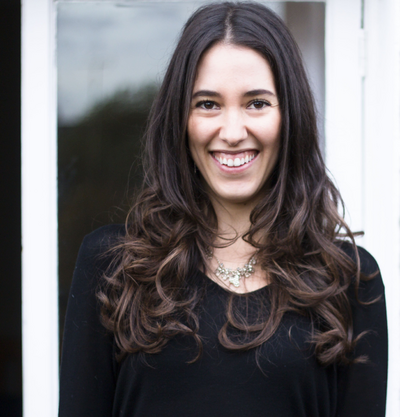
Inês ist Kuratorin und Autorin und lebt in London. Sie arbeitet mit Künstlerateliers an kuratorischen Projekten, Produktions- und Entwicklungsstrategien. Zu ihren Forschungsinteressen gehören Ökologie, Land Art, Feminismus, neuer Materialismus, Sprache, Fiktion und Text in der Kunst. Sie hat Kunstgeschichte und Sozialanthropologie an der Universität St. Andrews studiert und ist Absolventin des MA in Curating Contemporary Art des RCA und hat mit Institutionen zusammengearbeitet wie Folkestone Triennial, UP Projects (London), Create London, Bluecoat (Liverpool), Kunstverein München, Toronto Biennial, Kai Art Center (Tallinn), Art Night (London), The London Contemporary Music Festival (London), Open Space (London), MeetFactory (Prag), SitxtyEight Art Institute (Kopenhagen), Fondazione Sandretto Re Rebaudengo (Turin), das Curatorial Program for Research (Ostsee) und Kunsthalle Lissabon (Lissabon).
